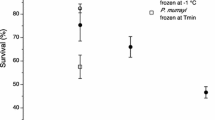Summary
Population growth of the High Arctic free-living soil nematode Chiloplacus sp. was measured at 0°, 2°, 5°, 10°, 15°, 20° and 25° C. The corresponding values of the intrinsic rate of natural increase, r, were 0, 0.0178, 0.0605, 0.0823, 0.1216, 0.1384 and 0.2131 respectively. The relation of r to temperature is described by the function r=0.0088+0.0075T. Chiloplacus sp. grows and reproduces at lower temperatures than do many other nematodes, and has shorter generation times at comparable low temperatures, suggesting rate compensation to low temperature.
Similar content being viewed by others
References
Alongi DM, Tietjen JH (1980) Population growth and trophic interactions among free-living marine nematodes. In: Marine Benthic Dynamics (KR Tenore, BC Coull, eds), University of South Carolina Press, Columbia, pp 151–166
Birch LC (1948) The intrinsic rate of natural increase of an insect population. J Anim Ecol 17:15–26
Gerlach SA, Schrage M (1971) Life cycles in marine meiobenthos. Experiments at various temperatures with Monhystera disjuncta and Theristus pertenuis (Nematoda). Mar Biol 9:274–280
Gowen SR (1970) Observations on the fecundity and longevy of Tylenchus emarginatus on sitka spruce seedlings at different temperatures. Nematologica 16:267–272
Greet DN (1978) The effect of temperature on the life cycle of Panagrolaimus rigidus (Schneider). Nematologica 24:239–242
Grootaert P, Maertens D (1976) Cultivation and life cycle of Monochus aquaticus. Nematologica 22:173–181
Heip C (1977) On the evolution of reproductive potentials in a brackish water meiobenthic community. Microfauna Meeresboden 61:105–112
Heip C, Smol N, Absillis V (1978) Influence of temperature on the reproductive potential of Oncholaimus oxyuris (Nematoda: Oncholaimidae). Mar Biol 45:255–260
Hochachka PW, Somero GN (1973) Strategies of Biochemical Adaptation. Saunders, Philadelphia
Hooper DJ (1970) Handling, fixing, staining and mounting nematodes. In: Laboratory methods for work with plant and soil nematodes (JF Southey, ed). Ministry of Agriculture, Fisheries and Food, London, pp 39–55
Mianowska E (1976) Research on the biology and ecology of Panagrolaimus rigidus (Schneider) Thorne. V. Effect of temperature on fecundity and development. Ekol pol 24:273–279
Patten BC (1975) Ecosystem linearization and evolutionary design problem. Amer Nat 109:529–539
Popovici I (1973) The influence of temperature and of nutrient medium on populations of Cephalobus nanus (Nematoda, Cephalobidae). Pedobiologia 13:401–409
Procter DLC (1979) Energy flow through free-living soil nematodes in High Arctic terrestrial communities. Ph D Thesis, University of Alberta
Sohlenius B (1968) Influence of microorganisms and temperature upon some rhabditid nematodes. Pedobiologia 8:137–145
Sohlenius B (1973) Growth, reproduction and population dynamics is some bacterial feeding nematodes. University of Stockholm, Sweden
Sokal RR, Rholf FJ (1969) Biometry. Freeman, San Francisco
Thomas PR (1965) Biology of Acrobeles complexus Thorne, cultivated on agar. Nematologica 11:395–408
Tietjen JH, Lee JJ (1972) Life cycles of marine nematodes. Influence of temperature and salinity on the development of Monhystera denticulata Timm. Oecologia (Berlin) 10:167–176
Tietjen JH, Lee JJ (1977) Life histories of marine nematodes. Influence of temperature and salinity on the reproductive potential of Chromadorina germanica Bütschli. Mikrofauna Meeresbod 61:263–270
Wallace HR (1961) The bionomics of the free living stages of zooparasitic and phyto-parasitic nematodes—a critical survey. Helminth Abstr 30:1–22
Widden P (1977) Microbiology and decomposition on Truelove Lowland. In: Truelove Lowland, Devon Island, Canada: A High Arctic Ecosystem (LC Bliss, ed). University of Alberta Press, Edmonton, pp 505–530
Author information
Authors and Affiliations
Rights and permissions
About this article
Cite this article
Procter, D.L.C. Population growth and intrinsic rate of natural increase of the high arctic nematode Chiloplacus sp. at low and high temperatures. Oecologia 62, 138–140 (1984). https://doi.org/10.1007/BF00377387
Received:
Issue Date:
DOI: https://doi.org/10.1007/BF00377387




